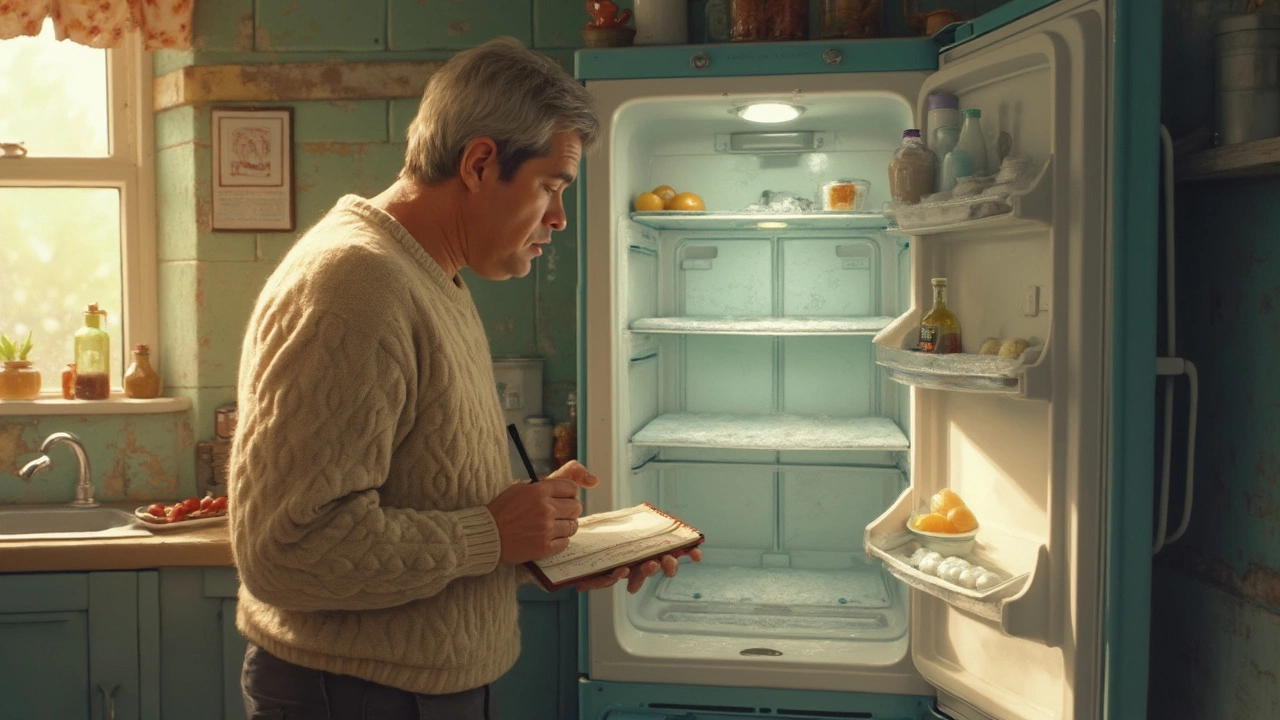So, your fridge isn't cooling like it used to, and things are getting a bit too warm for comfort? Before you panic-buy a new appliance or spend hours searching for the perfect repair service, let’s figure out if your fridge compressor might be to blame. A faulty compressor can sneak up on you, causing your energy bills to rise while your veggies start wilting. But fear not, there are some simple signs to look for.
First off, check the obvious: is your fridge not as chilly inside? Is the compressor running constantly without a break, or strangely silent? Any unsettling noises, like humming or clunking, that just started recently? These could be flashing red lights indicating your compressor’s not doing its job properly.
Don’t worry, you don’t need to be an appliance guru to perform a basic check-up. Sometimes, the issue isn't the compressor at all. It might just be a tripped circuit breaker or an overstuffed fridge limiting airflow. Make sure your fridge is plugged in properly, and clear any blockages around the vents.
- Signs Your Compressor Might Be Failing
- Common Causes of Compressor Failure
- DIY Solutions Before Calling the Pros
- When to Seek Professional Help
Signs Your Compressor Might Be Failing
Alright, let’s get straight to it. How do you spot a failing fridge compressor without calling a pro? Well, there are a few tell-tale signs, and some are more obvious than others.
1. Warm Fridge Interior
If the inside of your fridge feels more like room temperature, it’s a major red flag. The compressor’s job is basically to keep things cool, so if it’s failing, the temperature inside your appliance will rise.
2. Constantly Running Compressor
Normally, a compressor won’t run non-stop. It cycles on and off as it maintains the correct temperature. But if it seems like it’s running a marathon 24/7, something’s up. This often indicates the compressor is struggling to keep your fridge cool, a common fridge troubleshooting indicator.
3. Strange Noises
Is your fridge throwing a noise party? A compressor usually hums quietly, but if you hear loud humming, buzzing, or clunking, it could be in trouble. Keep in mind that while a little noise is normal, consistent or unusual sounds often point to compressor issues.
4. Overheating Back of the Fridge
Feeling the back of your fridge is a simple DIY test. If it’s excessively hot to touch, there might be a problem. While a bit of warmth is okay, overheating suggests your compressor is overheating too.
If you’ve ticked off any of these boxes, there’s a good chance your compressor needs attention.
Quick Check Before Panic
Before assuming the worst, rule out any power issues. Ensure your fridge is properly plugged in and the breaker hasn’t tripped. Then, assess the overall load inside your fridge; a stuffed fridge can restrict airflow and mimic compressor issues. Follow these steps to ensure your compressor complaints aren't just common misunderstandings.
Common Causes of Compressor Failure
Understanding why your compressor might fail is key to keeping your fridge repair cost down. These machines, like many household appliances, can bite the dust for a range of reasons.
Age and Wear and Tear
One big offender is simply age. Just like our old cars, compressors experience wear and tear over time. As they run day in and day out, their parts can get tired and less effective, ultimately affecting the fridge's performance.
Dirty Coils
Dirty coils are another culprit, easily overlooked. Dust and grime can build up on the condenser coils, making it hard for the compressor to release heat. This forces the compressor to work overtime, shortening its lifespan. Regular cleaning can prevent this.
Electrical Problems
Electrical issues are also known partners-in-crime when it comes to compressor issues. Power surges or faulty wiring can disrupt the steady voltage your compressor needs. This might cause the compressor to either manage poorly or stop working altogether.
Refrigerant Leaks
Finally, refrigerant leaks can play a sneaky role. Without enough refrigerant circulating, the compressor can't effectively cool your food. Leaks might start small but can quickly become a serious problem.
| Cause | Impact |
|---|---|
| Age | Reduced efficiency, possible failure |
| Dirty Coils | Overheating, increased effort required by compressor |
| Electrical Problems | Inconsistent operation, possible damage |
| Refrigerant Leaks | Insufficient cooling, potential compressor burnout |
Knowing these causes helps you spot problems early on, so keep an eye on your fridge’s health to avoid unexpected breakdowns.

DIY Solutions Before Calling the Pros
Before you rush to call a repair technician for your fridge compressor, there are a few do-it-yourself checks that could save you time and money. These tips are practical, easy to follow, and can often solve the problem without professional help.
Check the Power Supply
Sounds simple, right? Yet, a lot of issues stem from something as basic as a loose plug or a tripped breaker. Make sure the power cord is securely in the outlet. It's also a good idea to check your home’s electrical panel to ensure the breaker hasn't been tripped.
Inspect the Condenser Coils
Dust and dirt build-up on the condenser coils can cause your fridge to run inefficiently, making the compressor work overtime. Unplug your fridge and gently clean the coils with a vacuum cleaner or a coil brush. Depending on your fridge model, these coils are typically located at the back or underneath.
Check the Thermostat Settings
If your fridge thermostat is set too low, it might cause the compressor to work harder and eventually lead to issues. Adjust the settings to the recommended level – usually around 37°F for the fridge and 0°F for the freezer. Give it a few hours and monitor if there's any improvement.
Clear the Vents
Believe it or not, an overstuffed fridge can block the vents, restricting proper airflow and causing cooling problems. Make sure air can circulate freely by organizing your fridge’s contents better. Leave some space between items and avoid blocking any vents inside.
Tighten Loose Components
Open up the back panel carefully, and look for any loose nuts or components that might be causing noises or unusual vibrations. Don’t forget to tighten them cautiously to avoid any further issues.
If you try these DIY solutions and your fridge isn’t back to its cool self, it may be time to consider professional help. But hey, at least you gave it a shot and might have learned something useful in the process!
When to Seek Professional Help
There comes a time when your DIY attempts aren't cutting it, and you need to bring in the pros. Knowing when to call for professional repair can save you money in the long run and prevent temporary fixes from turning into bigger issues. But how do you know when it's time to make that call?
First, if your fridge has stopped cooling entirely and you've done all the basic troubleshooting—checked the plug, adjusted the thermostat, and cleaned the coils—but nothing's changed, it's probably time to contact a professional. Consistent fridge troubleshooting without results usually means there's something more serious at play.
Persistent Noise
If your fridge is making strange sounds even after dealing with possible blockages or aligning it properly, this could indicate mechanical issues with the compressor, or something else substantial. A constant hum might be normal, but banging, buzzing, or grinding should raise alarms.
Warm Fridge and Freezer
Another sign to seek professional help is if both your fridge and freezer compartments are warming up despite obvious efforts to cool them down. This could mean a failure in the compressor that generates the required cold air.
Visible Damage or Leaks
Liquid pooling around or inside the fridge, with no clear source from containers or spillage, is usually a sign of mechanical failure or condensation issues linked to the appliance maintenance. Strange odors can also hint at something wrong under the hood.
Finally, if you notice a jump in your energy bills without a clear reason, it might be time to get the appliance maintenance experts involved to check if your fridge is running inefficiently, which often ties back to compressor troubles.
Here’s a helpful table showing general costs for common fridge repairs:
| Issue | Estimated Cost |
|---|---|
| Compressor Replacement | $200 - $500 |
| Thermostat Repair | $100 - $300 |
| Coil Cleaning | $75 - $150 |
Remember, regular appliance maintenance can avoid a world of hassle, so if you've tried troubleshooting but still suspect something’s wrong, get in touch with a professional. They can offer a long-term solution, ensuring your fridge keeps your food fresh without breaking the bank.
